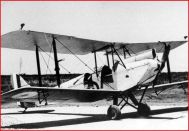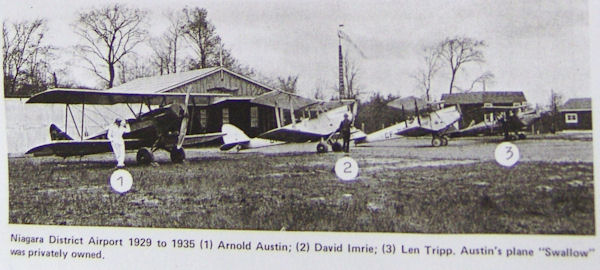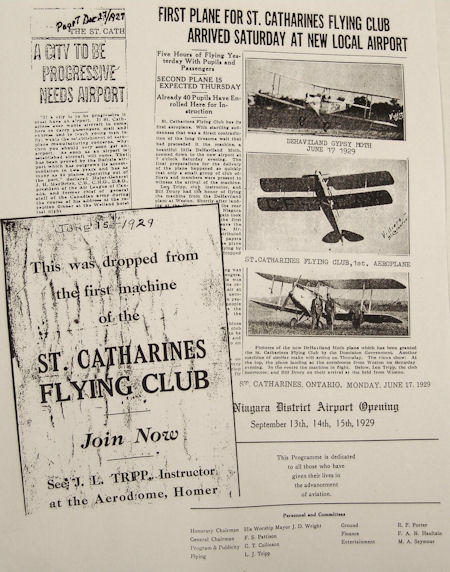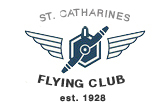OUR HISTORY

The St. Catharines Flying Club is located at Niagara District Airport. We are one of the oldest flying clubs in Canada, having formed the club in May 1928 and having received our charter in May 1929 with a DeHavilland DH60M Metal Moth marked CF-CAW as our first trainer.The Moth was granted from the “Dominion Government”.
In 1929, the facilities were described by the St. Catharines Flying Club in one of their publications as follows:
Pre-World War II
Niagara District Airport, established and operated by Haney Repair Service of St. Catharines, comprises about 100 acres and is located immediately south of Canada’s busiest provincial highway, No. 8, three miles east of St. Catharines and adjacent to the great Welland Ship Canal.
Though only three months under preparation it affords 2,400-ft. runways in all directions except east and west, where, due to the fact that the field’s location in relation to the Niagara Escarpment, makes direct east and west winds almost impossible. A temporary length of 1,200 feet has been prepared.

A light aeroplane hangar has been constructed, Hydro power and telephone installed and gasoline and oil servicing facilities are conveniently located.
The port has a 1,200 ft. highway frontage with a 300 ft. approach and the Airport Inn at this approach. Excellent dining rooms, refreshment stand, tourist hut and dancing services are always available at the Inn and buses taken at convenient intervals for all points from Buffalo to Toronto.
Being located adjacent to the Welland Ship Canal, one mile from the main line of the Canadian National Railway, three-quarters of a mile from the Queenston Hydro power lines, and in the very centre of the Peninsula’s three largest adjacent communities (St. Catharines, Merritton and Thorold) it offers aviation industry all that could be desired and being only one mile from the half-hourly radial service which serves every community on both sides of the Niagara River, it offers easy access to the airways of Canada and the United States.
By arrangement of a grant by the City of St. Catharines covering the club’s rental, the St. Catharines Flying Club can operate from the field for a period of five years. Aeronautical Services Ltd. distributors of Curtiss Reid for Lincoln, Welland and Wentworth Counties, also make it their headquarters.
- March 1929 – The St. Catharines Flying Club (S.C.F.C.) completed the requirements necessary to qualify for government assistance.
- June 1929 – The S.C.F.C. received its first aircraft and became operational.
- September 13–15, 1929 – Official opening of the S.C.F.C.

World War II – No. 9 Elementary Flying Training School (E.F.T.S.)
Murton A. Seymour, president of the St. Catharines Flying Club (S.C.F.C.) was instrumental in forming the Canadian Flying Clubs Association. He travelled to Ottawa in 1939 to meet the Minister of National Defence, Ian Alistair Mackenzie, in an attempt to have the government support air training through existing flying clubs.
With the outbreak of World War II many flying clubs, including the S.C.F.C, saw their resources being stretched to the limit. This was due to new members hoping to gain qualifications in an attempt to automatically qualify for the Royal Canadian Air Force.
Seymour advocated for the placement of an Elementary Flying Training School (E.F.T.S.) at St. Catharines as part of the British Commonwealth Air Training Plan. This goal was realized on 12 August 1940 when the Royal Canadian Air Force Headquarters announced the creation of No. 9 E.F.T.S. to be located at St. Catharines. The school was set to open on 15 March 1941 with an initial intake of 24 students. Shortly thereafter, an order was received from Ottawa announcing that the new opening date was to be 15 October 1940 and that the school was expected to accept 28 students.
One of the challenges faced by the S.C.F.C. was soft field conditions. To counter this, construction of new runways began in May 1941, which helped to ensure the permanency of the St. Catharines airport.
No. 9 E.F.T.S. was formally disbanded on 14 January 1944. When the school closed it had accepted 2,468 student pilots. Of these, 1,848 graduated from the program. The total air time for the school was 134,011 hours.
After No. 9 E.F.T.S. was disbanded the airport became home to RCAF No. 4 Wireless School Flying Squadron. This unit was located at the airport until 15 August 1945.
